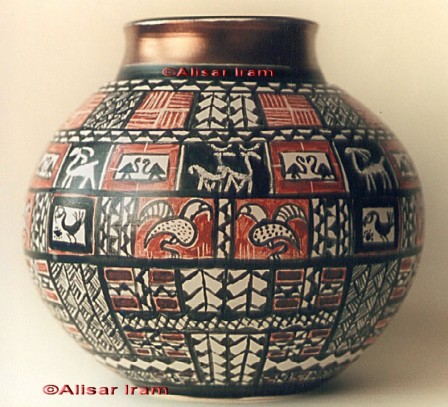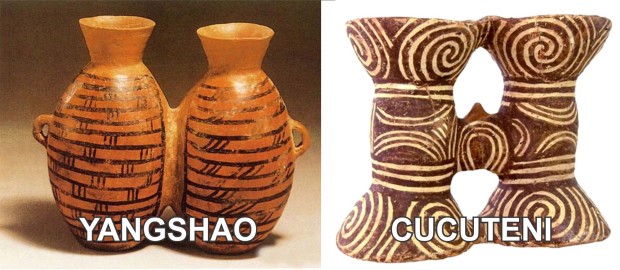Painted Pottery


This painting is based on the early pre-Indo-European Neolithic cultures of the Balkans and Turkey, marking the development of early agriculture
The central figure is based on an anthropomorphic pot from Hacilar, similar to many found throughout the region. She is on a scale with the mountains, so she is both mountain and pot. She holds another, smaller pot, into which the dead, in skeleton form, are climbing and where they seem to be having a party (this is the Balkans, and funerals are always occasions for parties).
She is surrounded by artifacts from the region, which populate her world. In the upper right corner is the moon, surrounded by a crescent moon design from a painted pot. The moon is reflected in the pool in front of her, which is fed by a mountain stream, but also milk from her breast.
Clay figurines of horned beasts are drinking from the pool, which is also home to the flock of waterbirds in the upper left. The flock is accompanied by another clay figure of the mother with a bird’s head in a chariot (another vessel).
The clouds and rain gathering at the top of the mountain are also from the design on a painted pot, and cattle and sheep (horned beasts) graze in the background. In the front left corner more clay female figurines bake bread in a model oven found in Bulgaria.
The oven echoes the form of the central figure and is another vessel which produces food for people. The bread in the foreground is used in present-day fertility rituals as observed by Matsen in Koprivshtitsa, Bulgaria. To the right is another modern harvest ritual from Koprivshtitsa, with ancient roots
Old World Geometry and Ancient Symbols
Like written language, symbols carry with them meaning that allows us to communicate with each other. But unlike language, many ancient symbols also contain something more. A deep meaning that lies in the base of our subconscious.
Carl Jung called those symbols Archetypes as archaic images or universal thought-forms that influence the feelings and action of an individual. He proposed that these images, patterns or prototypes for ideas are derived from the universal or collective unconscious.
According to Jung, the collective unconscious is an inherited psyche or reservoir of experience and is common to all members of a specific species. Archetypes can be described as blueprints of our souls. These are primordial images or patterns of behavior that we are born with. The great Greek philosopher, Plato is credited with originating the concept of Archetypes.
Symbols from ancient times can often carry more than 1 meaning. For example, a plus sign + can mean cross such as in religion or it can mean the 4 cardinal directions, north, south, east and west.
The ‘Supreme Ultimate’ diagram of Taoism, the Taijitu of Yin and Yang dates back in China to around a couple of thousands years ago, yet its origins can be found much earleir among the Old European cultures like Cucuteni and Trypillia dating to around 7000 years ago.
Old World Geometry and Ancient Symbols
Painted Pottery Cultures
Because of discoveries of earlier pottery traditions made starting in the 1990s, the time frame for the initial Late Neolithic ceramic period is thought to be roughly 7000-6700 BCE. The earliest pottery of Syria was discovered here; it dates at ca. 6900-6800 BC, and consists of mineral-tempered, and sometimes painted wares.
These earliest pottery traditions may be known in literature as ‘Initial Pottery Neolithic’ in the Balikh River area of Syria and Turkey, for example Tell Sabi Abyad. Or it may be known as ‘Halula I’ in the Syrian Euphrates area; the main site is Tell Halula. Also, it may be known as ‘Rouj 2a’ in Northern Levantine Rouj basin (Idlib, Syria).
By the earliest PN phase pottery was ubiquitous and it remained so for virtually all periods in the southern Levant until modern times. Exceptions were in desert areas where semi-nomads favored less heavy, fragile and bulky arrangements.
Pottery styles, based mostly on form, fabric and decorative elements have been used to help identify chrono-cultural phases. White ware remained in use, but it seems to have remained rare and the vessels were often small and rather delicate.
It is possible that not a few such vessels were found and identified as pottery. The earliest PN phase in the Southern Levant is associated with the site of Sha’ar HaGolan in the Jordan Valley. This pottery is sometimes called “Yarmukian Ware” (6400–6000 BC).
Painted Pottery Cultures the general name accepted in the literature for archaeological cultures of the late Neolithic period and of the Aeneolithic period. The name is based on the characteristic feature of the cultures – painted decorative pottery.
The painted pottery cultures are characterized by the predominance of farming using the hoe, combined with stock raising, fishing, and hunting; the appearance of copper tools at a time when flint prevailed; large, usually pisé, houses; and clay female statuettes.
The oldest settlements with painted pottery existed in Northern Mesopotamia. Painted pottery cultures later appeared in what is now the Ukraine and Moldavia (Tripol’e culture), Rumania, Bulgaria, Greece, Yugoslavia, the Caucasus, Iran (Sialk), Middle Asia (Anau and Namazga-Tepe), India, and China (Yang-shao).
The painted pottery cultures were created by different tribes. The similarities of the cultures were probably determined by the tribes being at the same stage of economic and social development and living under similar geo-graphical conditions.
The site of Tell Sabi Abyad in Syria offers a superb stratified sequence passing from the aceramic (pre-pottery) to pottery-using Neolithic around 7000 BC. Surprisingly the first pottery arrives fully developed with mineral tempering, burnishing and stripey decoration in painted slip.
The expected, more experimental-looking, plant-tempered coarse wares shaped by baskets arrive about 300 years later. Did the first ceramic impetus come from elsewhere?
The pottery of ancient Tell Halaf of Mesopotamia and my ceramics
The amazing similarities between the Cucuteni culture and the Chinese Yangshao culture
Painted Pottery Culture: 5000-2500 BCE
Not so coarse, nor always plain – the earliest pottery of Syria
A DNA Genealogy Solution to the Puzzle of Ancient Look-Alike Ceramics across the World
7,000 year old origins of ‘The Supreme Ultimate’
Laozi, Taoism, Taijitu, Taegeuk, Taiji (philosophy), Wuji (philosophy)










Hassuna, Halaf, Samarra – Northern Mesopotamia, 7000-6000 BC










Cucuteni-Trypillian


 Ukraine Pavilion of Expo 2010
Ukraine Pavilion of Expo 2010








Painted Pottery China:
Yangshao/ Majiayao/ Machang/ Banshan culture

Ornamental Bronze Plaque, Celtic Horse-gear, Santon, Norfolk

Celtic Bronze Disc, Longban Island, Derry

Shield pattern of the Roman Mauri Osismiaci (ca. AD 430), with the dots in each part kept in the same shade of color

Coat of arms of the Roman armigeri defensores seniores (4th row, third from left), dated to ca. AD 430

Ancient form of the Taijitu, as used by Lai Zhide

Korean flag


